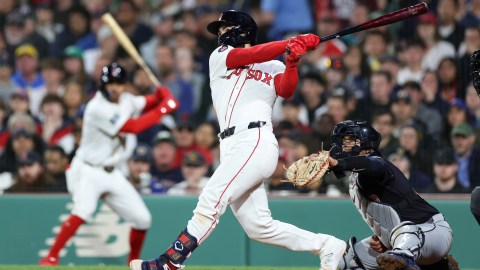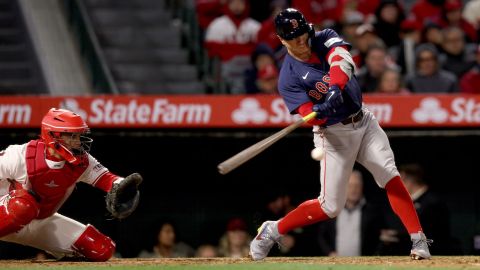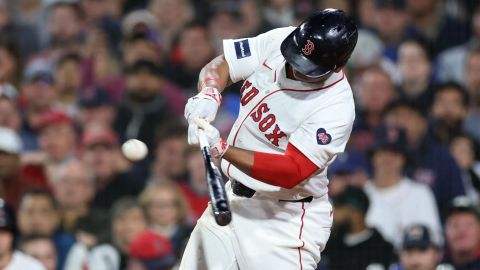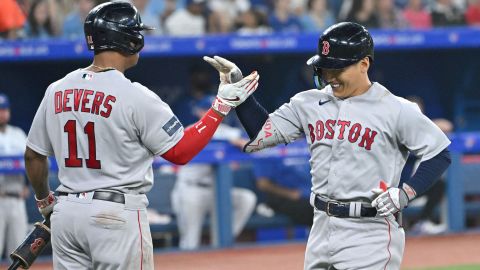On Thursday, we kicked off our Top 100 prospects countdown with the bottom 20 minor leaguers on the list, highlighting some talented young pitchers, toolsy outfielders and role players who are close to the majors.
On Friday, we now delve into the next 20 prospects, and bring you some potential mid-rotation starters, impact position players who are still several years away and another crop of outfielders with even more talent than the last. This part of the list includes several players who are likely to make their MLB debuts in 2012, so fans of all teams should take note.
80. Tyler Thornburg, starting pitcher, Milwaukee Brewers
A small right-hander with big-time strikeout stuff but some command issues, Thornburg is an intriguing prospect with a high floor as a reliever, but a low one as a starter. Just under six feet tall, Thornburg threw 136.2 innings between Single and High-A last season, striking out 160 batters in that time but walking 58 as well. If he proves to be durable and can keep the ball on the ground, he’s a number two starter. If not, he’s a strong candidate to be a future closer.
79. Nathan Eovoldi, starting pitcher, Los Angeles Dodgers
Eovoldi was rushed to the majors in 2011, causing some to overrate him as MLB-ready and others to discount him since he didn’t perform particularly well there. Still just 21, Eovoldi should spend most, if not all, of 2012 at Triple-A, where he can refine his control and his off-speed pitches. Eovoldi’s strikeout and groundball rates lend themselves to success, though, and he should be a mid-rotation starter after another 120 minor league innings.
78. Mike Olt, third baseman, Texas Rangers
It’s easy to get excited about Olt’s power and patience, and he’s likely to be an average defender at third base as well. He’s played only 169 career professional games, though, and none of those have come above High-A despite his relatively advanced age of 23. College players are supposed to perform well in the low minors, so Olt can’t be considered an elite prospect until he proves himself against tougher competition.
77. Javier Baez, third baseman/shortstop, Chicago Cubs
The ninth overall pick in the 2011 draft, Baez has an exciting bat but major flaws as well. He’s very unlikely to stay at shortstop — with a move to third base likely coming within the year — and Baez has been accused of having character issues as well. That being said, his hit-and-arm tools are already above average, and scouts think he’ll grow into power, so he could become a prototypical mashing third baseman in time.
76. Tim Wheeler, outfielder, Colorado Rockies
The good –- Wheeler mashed 33 homers, 28 doubles, stole 21 bases and manned center field in Double-A in 2011. The bad –- he’s already 24, may be a right fielder in the long run and he struck out in 22.3 percent of his at-bats. Add it all together and Wheeler is an intriguing prospect, but not as elite as his stat line would lead you to believe. Still, his floor is decently high as a power-hitting right fielder who can play well in a corner spot.
75. Starling Marte, outfielder, Pittsburgh Pirates
Statistically speaking, Marte had a phenomenal 2011 campaign, hitting .332 with a .370 OBP, 58 extra base hits (XBH) and 24 steals. There’s plenty to suggest that luck factored into his success, though, as Marte’s .390 batting average on balls in play was insanely high, even for someone with his speed. Marte figures to be a plus defender in center and has enough power to keep pitchers honest, but will need to improve his approach if he’s to become a star. He should be MLB-ready by July.
74. Sonny Gray, starting pitcher, Oakland Athletics
Gray was the 18th overall pick in the 2011 draft, which will make him a bargain if he can start or a reach if he ends up in the bullpen. Gray’s fastball and curveball are both above-average pitches, and the latter in particular has the ability to become special. However, Gray’s changeup isn’t MLB-ready, he has a small frame and erratic delivery and his command is just average. The A’s will give him every chance to start, and he should spend 2012 in Double-A.
73. Trevor May, starting pitcher, Philadelphia Phillies
May had an excellent 2011 season, putting up some eye-popping strikeout numbers while producing a Fielding Independent Pitching (FIP) mark of 2.69. His success does come with some caveats, though, as May was repeating High-A as a 21-year-old and still walked over four batters per nine innings. May has No. 2 starter potential, but will need to improve his command and start inducing more groundballs if he’s to fully develop.
72. Nestor Molina, starting pitcher, Chicago White Sox
Traded to the White Sox in December for Sergio Santos, Molina immediately became the best prospect in what is a barren system. After a solid 2010 campaign, the 23-year-old righty dominated in High-A last season, striking out over one batter per inning while inducing a fair amount of ground balls. Molina doesn’t rank higher because he isn’t young for his league and some fear he’ll end up in the bullpen, but the bet here is that his control allows him to become a mid-rotation starter by 2013.
71. Jon Schoop, second base, Baltimore Orioles
Schoop had an exciting season in 2011, reaching Double-A at the age of 19 and largely holding his own there after dominating in High-A. Schoop’s patience and power regressed once he reached the higher level, though, and he’ll likely need to spend all of 2012 refining his approach there. Schoop profiles as a good defender at second with unusual power for the position, and should be MLB-ready by mid-2013. He and Manny Machado make for one of the more exciting middle-infield prospect duos in baseball.
70. Taylor Jungmann, starting pitcher, Milwaukee Brewers
This may be the highest you’ll see Jungmann on any list, but while the big right-hander lacks ace potential, he was one of the safest picks in the 2011 draft and should be MLB-ready at some point in 2013. He hasn’t thrown a professional pitch yet, but there’s no reason he should start 2012 anywhere lower than High-A, and it’s not hard to envision him ending the year in the upper minors. He profiles as a durable, mid-rotation workhorse in the Jeff Niemann mold with a chance to be something more.
69. Josh Bell, outfielder, Pittsburgh Pirates
The surprise sign of the 2011 draft, Bell was viewed as a lock to temporarily forgo professional ball and attend the University of Texas, but the Pirates changed his mind with a $5 million contract. Bell was one of the top 10 talents in the draft, and profiles as a power hitter with the defensive chops to handle right field. He’s young and at least three seasons away, but the Pirates could be looking at a Mike Stanton-like player.
68. Christian Yelich, outfielder, Florida Marlins
Yelich had a phenomenal first full professional season in 2011, validating his status as the Marlins’ first-round pick in 2010. Despite playing the year at age 19, Yelich hit 15 homers, 32 doubles and reached base at a .388 clip, all while swiping 32 bases in 37 attempts in Single-A. He should move up to High-A as a 20-year-old in 2012, and if he performs that well again he’ll be an elite prospect. His upside is as a moderate five-tool center fielder.
67. Oscar Taveras, outfielder, St. Louis Cardinals
Taveras is high on many prospect lists this off-season, but while there’s plenty to like about him, he’s a bit overrated thanks to his outrageous .386 average. There’s no disputing that Taveras has an exceptionally polished approach for his age –- he won’t turn 20 until June –- but the .440 batting average on balls in play (BABIP) he posted last season is unsustainable. He lacks the range to play center and the power to profile in a corner outfield spot, so he’ll need to reach base frequently and get stronger to succeed. But the upside is there.
66. Nick Castellanos, third baseman, Detroit Tigers
Castellanos had a very solid first full professional season in 2011, hitting .317 with a .367 OBP and 46 XBH in Single-A. What’s troubling, though, is that he struck out in 23.1 percent of his at-bats while walking just 8 percent of the time, and he hit only seven home runs. He has all the natural skills to develop into a four-tool third baseman, but is still several seasons away from sniffing the majors. If he adds power without sacrificing his range in the field, he could move quickly.
65. Billy Hamilton, shortstop, Cincinnati Reds
Hamilton is the fastest player in the minors, and the 21-year-old stole 103 -– yes, 103 — bases in 135 games in Single-A last season. The biggest knock on Hamilton is his strength –- he’s wire-thin — and scouts fear he won’t have enough pop to keep pitchers honest or enough of an arm to stay at short. Still, the worst-case scenario for Hamilton is ending up as a plus center fielder in a mold similar to Michael Bourn. If he can stay at short, he’ll be a special player.
64. Dellin Betances, starting pitcher, New York Yankees
A high-risk, high-reward prospect, Betances seems destined to be a number two starter, an impact reliever or flame out completely. A physical monster at 6-foot-8, 260 pounds, Betances has always put up big strikeout numbers, but is held back by a lengthy injury history and command problems. He’s likely to spend 2012 at Triple-A and could see a few major league starts if all goes well. He’ll need to throw over 150 innings if he wants to prove he can start long term.
63. Xander Bogaerts, shortstop/third baseman, Boston Red Sox
Few prospects improved their stock in 2011 more than Bogaerts, who went from a relative unknown to the man many consider to be the best prospect in the Sox’ system. Scouts doubt whether Bogaerts will be able to remain at shortstop, but no one doubts his power, as the 19-year-old Aruban mashed 32 XBH in 265 at-bats in Low-A last season. If he continues to flash that kind of pop, he’d be comparable to a more athletic version of Twins’ prospect Miguel Sano, who ranks much higher on this list.
62. Casey Kelly, starting pitcher, San Diego Padres
Kelly had yet another fairly disappointing statistical season in 2011, posting a K/9 rate of just 6.64 and an ERA of 3.98 over 142.1 innings in Double-A. Scouts remain high on the pure quality of his stuff, though, and he did improve his command and velocity from 2010 while inducing ground balls at a high rate. There’s a tendency to ignore Kelly since he may not develop into the ace many originally thought, but he still has a high floor as a mid-rotation innings eater with the potential to be more.
61. Brad Peacock, starting pitcher, Oakland Athletics
If you think Peacock is a starter, you likely want him 20 spots higher than this. If you think he’s a reliever, you probably think he shouldn’t be on here at all. This ranking splits the difference and acknowledges Peacock’s phenomenal 2011 season, while also respecting the notion that he was pretty darn lucky last year too. Peacock will get the chance to be a starter this year and should rack up plenty of strikeouts, but he doesn’t induce enough groundballs to be more than a No. 3 or No. 4 starter. That being said, he’s ready to begin 2012 in the A’s rotation.
Prospects 1-20 I 21-40 I 41-60 I 61-80 I 81-100



